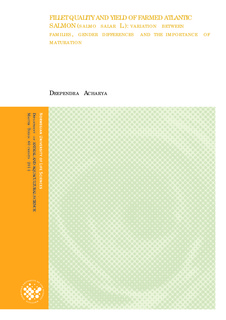| dc.description.abstract | The aim was to study biometric parameters, yield and fillet quality traits of farmed Atlantic salmon (Salmo salar L.) belonging to the 2008 year class of the breeding nucleus of SalmoBreed AS, Norway. The offspring analyzed belonged to 213 dams and 111 sires, in total 1181 individuals. The
salmon were transferred to seawater March 2009 and the different families were kept together in commercial net-pens until the fish was processed July 2010. The mean body weight of the immature male and female salmon was 5.50 and 5.30 kg, respectively. The difference between the sexes was even greater for the sexually mature fish, where the male salmon weight 1.20 kg more than the females (7.24 vs. 6.02 kg). The mean slaughter yield was similar for male and female salmon
(90.7%-90.8%). The average fillet fat content for male fish was about 16% whereas the fat content of female fish was about 15%. The breaking force of the mature salmon was significantly higher
than of the immature salmon regarding both sexes. The fillet color was significantly higher of the females compared with the males. The maturation had no significant effect on the fillet color, although mature males had higher frequency of pale patches on the anterior fillet part (pale back).
Immature females had significantly highest melanin deposition whereas the mature male had lowest melanin. The body weight, fillet yield, slaughter yield, condition factor, firmness, color, and fat content,
varied significantly between the families but no family variation in pale back, melanin deposition in the belly or gaping was observed regarding offspring from dams or sires. Positive correlations between yield and some quality traits (color, pale back and fat content) were observed. The body
weight was found to be positively correlated with the yield and condition factor.
The offspring from 5% of the dams and 11% of the sires had all the desirable quality traits: fat content less than 16%, intense visual color and firm texture. Among the dams and sires with offspring with desirable quality, one dam and one sire were selected that in addition to superior
quality, also had high body weight at slaughter. The body weight of these fish was 6.7 and 7.6 kg for the dam and sire, respectively. These results are encouraging, and suggest that it is possible to
obtain future generations of salmon with superior growth performance, high muscularity and yield, and also desirable fillet quality characteristics. | no_NO |
